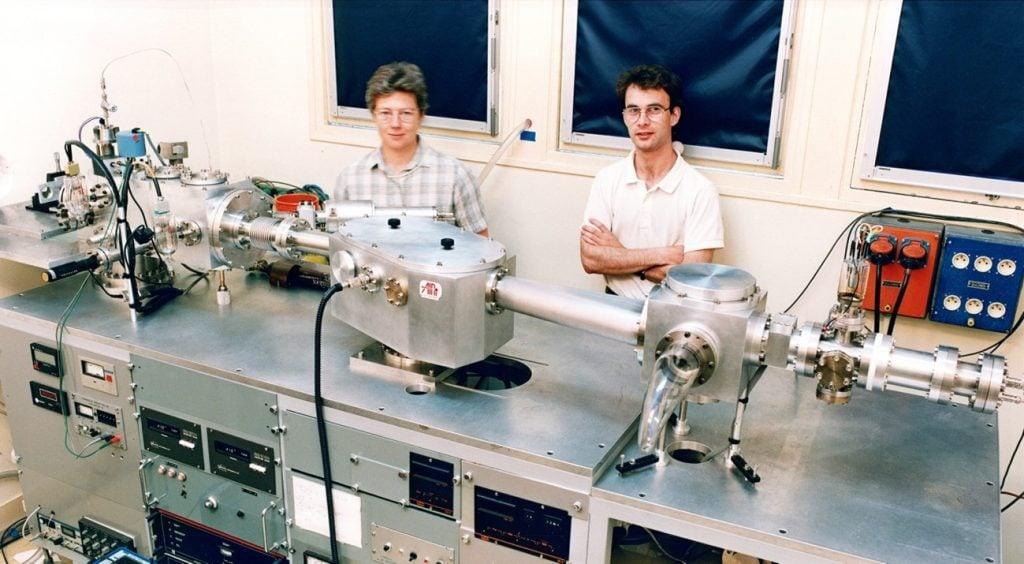A spark in France, a shift in Canada
In 1987, L’Huillier was a young researcher in France when she noticed something unusual while firing lasers into gas. Instead of producing fluorescent light from excited atoms, the laser generated high-order harmonics, light at multiples of the original frequency. Even more surprising, the intensity didn’t fade as expected. It reached a “plateau.”
Why was that significant? Normally, when you create harmonics (extra light frequencies that are multiples of the laser’s frequency), the higher-order ones fade quickly and almost vanish. But L’Huillier saw something extraordinary: the high-order harmonics were just as strong as the low-order ones. This plateau meant scientists could combine these harmonics to create ultra-short bursts of light, called “attosecond pulses.”
“That experiment changed the course of my career,” L’Huillier says. “I dedicated myself to understanding this effect.”
Across the Atlantic, Paul Corkum was working in plasma physics when he read L’Huillier’s papers. “She influenced me, for sure,” he says. “It essentially changed my direction in research. Eventually, I developed the ‘three-step model for high harmonic generation,’ which became the standard framework in the field.”

The seaweed analogy and the three-step model
To explain the breakthrough, Corkum reaches for an image from his East Coast roots.
“I often explain it with this analogy: imagine seaweed stuck to a rock. A wave comes in, lifts the seaweed and then it crashes back. That crash emits a burst — like the electron pulled from an atom and then driven back by the laser field. That burst is the attosecond pulse.”
This simple picture mirrors the three-step model, which Corkum developed to explain how attosecond pulses are created:
- Ionization: The laser’s electric field pulls an electron away from its atom, like the wave lifting the seaweed from the rock.
- Acceleration: The electron is driven by the laser field, gaining energy as it moves, like the seaweed drifting with the wave.
- Recombination: The electron crashes back into the atom, releasing its energy as a burst of light, just as the seaweed slams back into the rock. That burst is the attosecond pulse.
This model became the foundation of attosecond science, turning a puzzling observation into a predictable process and opening the door to controlling light at the fastest timescales imaginable.
Why it matters
Think of an attosecond pulse as the world’s fastest camera, so fast it can capture electrons in motion. That ability changes everything. For the first time, scientists can watch the building blocks of matter move in real time, revealing processes that were once invisible.
“Attosecond science gives us a new way of seeing,” Corkum says. “We can now study how electrons behave inside atoms, molecules and even solids.”
L’Huillier adds: “It’s still early days, but we’re beginning to apply these tools to chemistry, solid-state physics, quantum optics and even semiconductor inspection.”
Corkum sees something even bigger: “What excites me is that matter everywhere — gas, solid, even complex structures — may respond similarly to intense light. That makes attosecond science a universal tool, opening possibilities from probing new solids to exploring quantum effects in molecules.
The next frontier
For L’Huillier, the possibilities are intriguing. “One challenge is combining spatial and temporal resolution — essentially building a camera that can see both where and when things happen. We’re also exploring more complex systems and the intersection with quantum information science. Attosecond pulses give us tools to manipulate and measure quantum states in a new way. It’s a door to quantum technologies we haven’t yet imagined.”
Corkum is intrigued by something called “holes,” the absence of electrons. “When you pull an electron out, you leave behind a hole, and that hole behaves almost like a particle. We’ve known about this for decades, but we haven’t explored its dynamics at attosecond timescales. Understanding this could reveal new insights into materials and chemistry, especially in semiconductors and superconductors. And if you think about quantum computing, controlling both electrons and holes could give us entirely new architectures.”

A door wide open
For both scientists, the journey is about more than technology — it’s about wonder. “I was inspired by great teachers and the beauty of light-matter interaction,” L’Huillier says. “Attosecond science sits at the crossroads of atomic, molecular and optical physics. It’s a wide-open field, and I hope young scientists see the possibility in it.”
Corkum agrees. “The tools are there, but the real motivation comes from doing something unique and original. There are so many open questions — and attosecond science gives us a new way to explore them.”
As they reflect on their careers, both L’Huillier and Corkum express pride not only in the breakthroughs they’ve helped achieve, but in the vibrant field they’ve helped build. Their legacy isn’t just in the science — it’s in the door they’ve opened for the next generation to walk through, equipped with new tools, fresh questions and the curiosity to keep pushing frontiers.
Anne L’Huillier was the keynote speaker at this year’s Schawlow-Townes Symposium on Photonics, an annual event hosted by the University of Ottawa in partnership with the National Research Council of Canada. Established in 2012 to honour laser pioneers Arthur L. Schawlow and Charles H. Townes, the symposium showcases cutting-edge research and discoveries in photonics from leading experts around the world.
